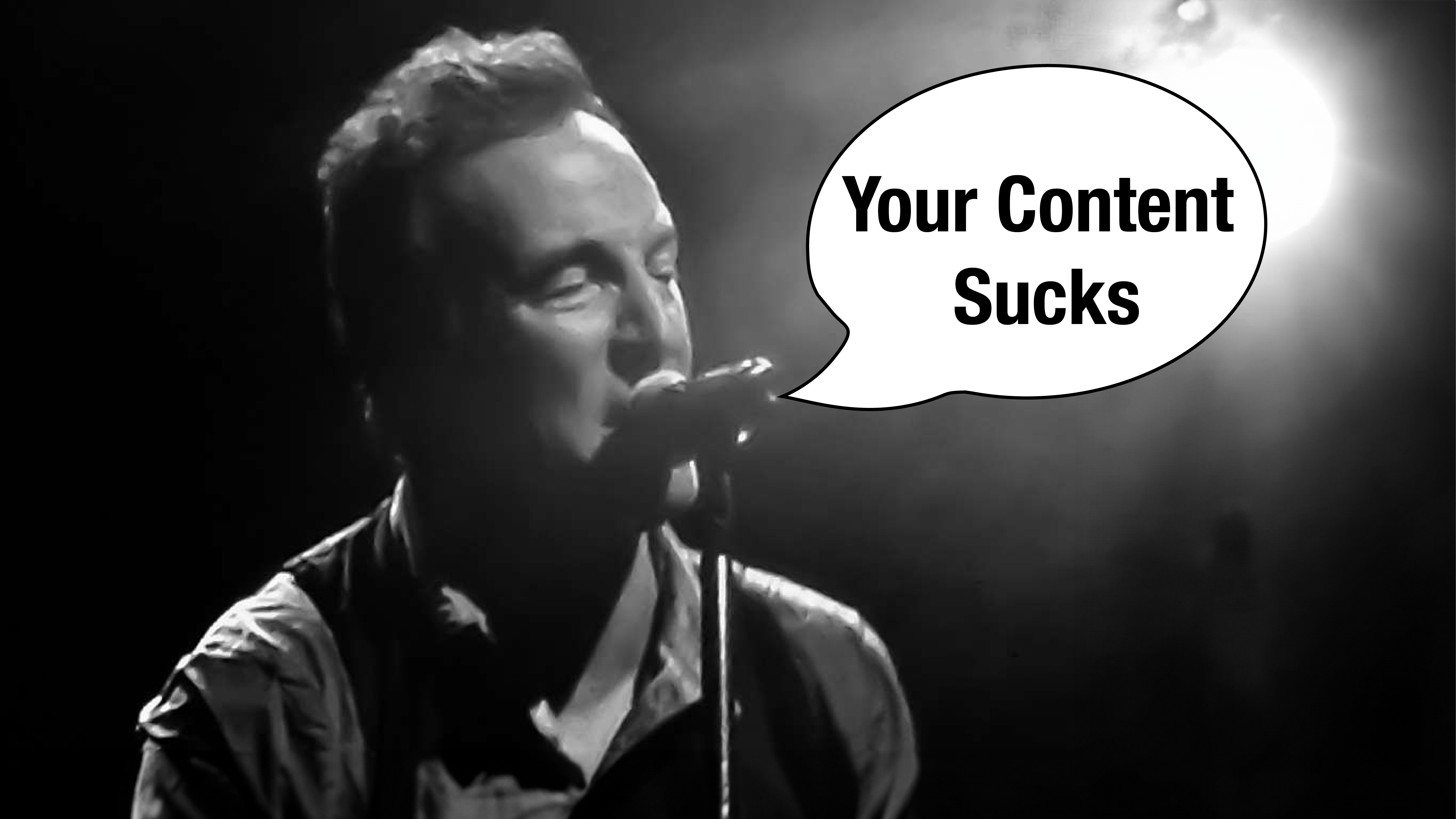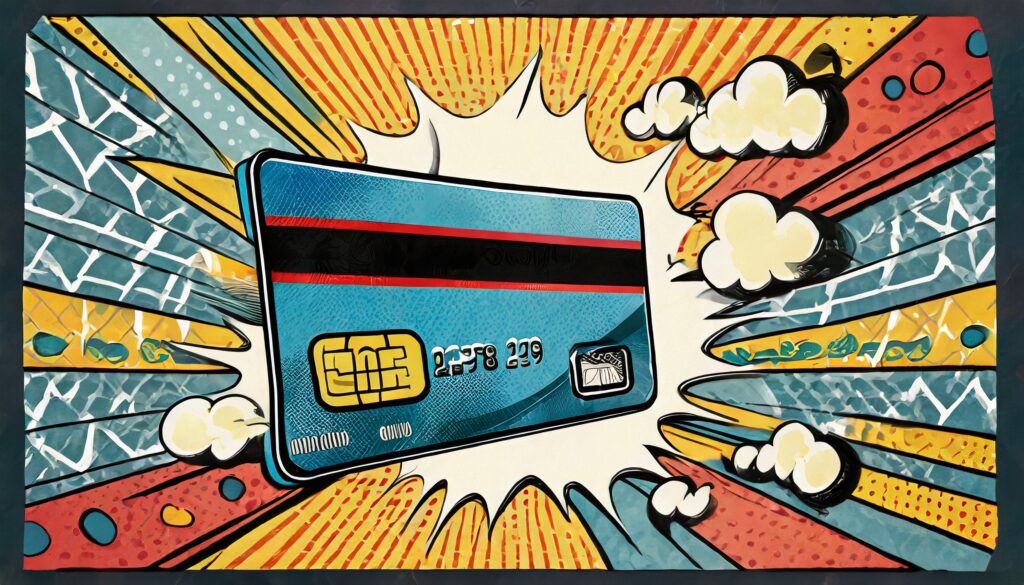Content marketing gets thrown around in board rooms and marketing review meetings without anyone at the table grasping the concept.
“We’ve got to cut ad spend,” they say. “Can we do content marketing? That’s free, right?”
Yes, you can do content marketing. And sure, it’s free from a line-item perspective.
But it requires a considerable time and personnel investment to get right.
And it’s easy to understand why content marketing has become such a buzzword. Everyone’s doing it.
H*ck, Bruce Springsteen called content marketing a magic trick during his Springsteen on Broadway show. Well, he called storytelling a magic trick because he’s probably never said the word content (must be nice).
Content marketing is powerful. It can grow an audience, keep repeat customers engaged, lighten your prospecting and sales burden, answer customer service questions, and attract new leads, all while the rest of your team is sleeping.
Content marketing can also elevate your organization to the enviable role of Industry Thought Leader (if that’s what you’re into).
So what is it?
Simply put: Content marketing is the use of multimedia storytelling and keyword optimization to attract and sustain a captive, easy-to-reach audience.
A word about the word “content.”
I hate the word content, which is a real conundrum for me, a content marketer. Ugh, I just typed it again.
“Content is king,” we say. We live in a content-driven economy. But content can also be cheap. At best, it’s a powerful tool. At worst, it’s a buzzword.
- When done right, content is storytelling that invites viewers, readers, audience members, and prospective clients into a larger story.
- When done wrong, content is stuffing. Think about a pillow. What’s inside the pillow? Stuffing? Fluff? Content.
A Semrush survey of marketing professionals found that 44% of businesses plan to increase their content marketing budgets by 11% or more. HubSpot’s 2023 Marketing Survey reports more than 90% of marketers expect to have the same or an increased budget in 2023.
That’s way too much money to be throwing away on stuffing.
If you’re doing content wrong, you’re part of why “content” is meaningless in 2024. But it’s ok. It’s not too late to stop shilling worthless content and start telling stories that matter.
Bruce Springsteen’s Content Marketing Magic Trick

I love Bruce Springsteen, and if you need proof, you can check out my very silly Springsteen podcast.
Bruce Springsteen describes songwriting and storytelling as his magic trick.
In “Springsteen on Broadway,” he jokes that he spent his whole career writing about a blue-collar life without ever having held an honest job. “I made it all up. That’s how good I am.”
His magic trick is taking something profoundly personal and specific to his experience and repackaging it into a lie everyone can relate to. Sometimes, we must understand someone else’s experience to understand our own.
“I always thought I was a typical American, and so I fought my whole life, and I studied, and I played, and I worked, ’cause I wanted to hear and I wanted to know the whole American story.
I wanted to know my story and your story. I felt like I needed to understand as much of it as I could in order to understand myself.
You know? Who was I? And…where I came from and what that meant?
What did it mean to my family? Where was I going? Where were we going together as a people? And what did it mean to be an American? And to be a part of that story in this place and in this time.
I wanted to be able to celebrate and honor its beauty its power. And I wanted to be able to be a critical voice when I thought that that’s what the times called for.
But most of all, more than anything else, I wanted to be able to tell that story well to you.
That was my young promise to myself. And this was my young promise to you… And this is what I have pursued as my service.
I still believe in it as such. This is what I’ve presented to you all these years as my long and noisy prayer, as my magic trick.”
Bruce Springsteen
How it works — A magician reveals his secrets.
Humans are built for storytelling. It’s a shortcut to evoke feelings, call on past experiences, and generate new in-group connections.
Jonathan Gottschall’s “The Storytelling Animal: How Stories Make Us Human” explores how story influences us on both the micro (our own brain’s gray matter) and macro (societies and governments) levels.
He sums it up nicely in his Ted Talk: “Our minds have a natural inclination to turn simple visual cues into complex stories, and we constantly seek to impose the structure of storytelling on the chaos of life.”
Our brains try to make sense of things, and narrative is how they do it. Because long before we had math and science, before language even, we had stories.
No matter how rational or logical you think you are (and I consider myself quite logical and sensible, so you’re not alone), your brain is a story-processing device first and foremost.
A friend and early mentor of mine used to constantly tell me, “I don’t care how smart you are. You make decisions with emotions and backfill with logic.”
💡Imagine an extremist organization. The kind of cult, government, or religion you find completely unpalatable and without reason. How did that group grow its ranks if it’s so detestable? It probably told a great story that resonated with that audience.
Storytelling influences the way someone feels. That feeling influences their decisions. Bruce Springsteen may have undersold his “magic trick.” Storytelling is a superpower, and with great power comes great responsibility. Be careful.
How do you tell a better story?
Starbucks tells a lot of stories. They talk about health, equity, environmentalism, and fair trade, to name a few.
But the first story most people hear from Starbucks is much simpler:
“Welcome. You belong here even if you think you don’t.”
The story starts in medias res, dropping you right into the action. It’s the best way to start a story.
A first-time coffee drinker walks into a well-appointed space full of smells and the din of conversation. The menu is inaccessible, mixing French, English, Spanish, and Italian all at once. It doesn’t use the “straight” word for half of its offerings.
Overwhelmed, they walk up to the counter and say, “I want a coffee.” The barista has follow-up questions. “Drip? Americano? Espresso? Tall or Venti?”
Want a sweet drink with some milk? That’s going to be a Caramel Machiatto or maybe a vanilla sweet-cream cold brew? Looking for something heavy and stout? That’s a brevé.
But, paradoxically, Starbucks is a gateway drug. It’s the window into a life of coffee snobbery for more people than nearly any other coffee brand.
How do they do it? Just when you’re starting to feel overwhelmed by the complexity of your coffee conundrum, they teach you the language. They invite you into a story.
Your story doesn’t have to be complicated. It simply needs to invite the audience in.
Make Your Audience the Main Character
💡 Think about an ad for your local community bank. It probably lists all the features of its checking account or CD rates. Sure, 5% is a great rate, and it’s nice to have ATM fees waived. But how does that separate your local bank from any other?

No one wants to read a comic book about a debit card.
What if you could tell a story of a family that doesn’t worry about money because they know their wealth is growing and their bank won’t nickel and dime them with fees?
What Content Marketing Looks Like in 2024
I’ve leaned pretty heavily on the 2023 HubSpot State of Marketing Report, but that’s because HubSpot has access to more data than most of us, and the data is current.
In that marketing report, marketing decision-makers said they expect the following channels to make the most significant impact in the coming year:
- Blog and SEO
- Podcasts
- Virtual Events
- SMS Marketing
- Direct Mail
- Long-Form Video
- Organic Social
Maybe the virtual event isn’t content (it probably is). Everything else is content marketing.
In the 2023 SemRush Content Marketing Survey, most respondents measured content ROI based on lead or organic traffic conversion. Another 24% of respondents said they measure content marketing ROI based on how much of the overall advertising budget they save.
It’s proven effective time and again.
But content isn’t just a lead-gen tool. 30% of Gen X respondents to the Hubspot Social media survey said they’ve purchased a product directly from social media. That makes ROI a lot easier to measure.
Content marketing will be the workhorse for most marketing teams, not just in the coming year but for the foreseeable future. The current media paradigm — social, mass, SEO — is fueled by content. Until the infrastructure changes, content marketing will continue to thrive.
Do you need help telling a better story?
I help people, organizations, and brands tell better stories. Stories that connect with their audience and drive key performance outcomes.
More simply, I help people demystify the magic trick. I can help you too.

